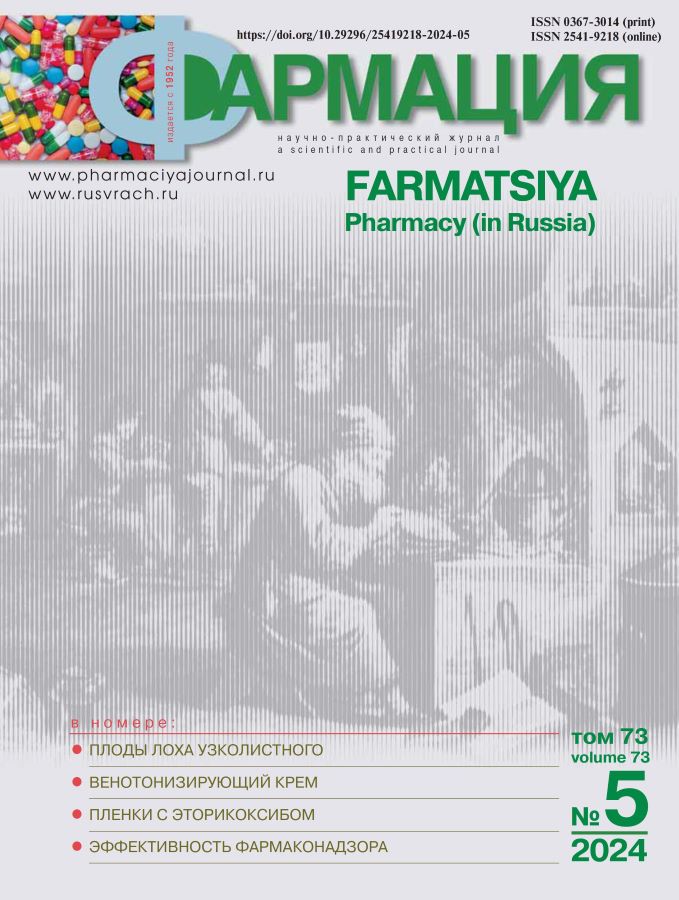Phytochemical and genoprotective features of Elaeagnus angustifolia L. fruit mesocarpy extract
- Authors: Schepetova E.V.1, Abdurakhmanova N.M.1, Prokopchuk T.M.1, Kondratenko E.I.2, Baikhanova O.D.3
-
Affiliations:
- Federal State Budgetary Educational Institution of Higher Education Astrakhan State University named after V.N. Tatishchev
- Federal Research Center Subtropical Scientific Center of the Russian Academy of Sciences
- State budgetary institution Professional educational organization Astrakhan Basic Medical College
- Issue: Vol 73, No 5 (2024)
- Pages: 5-13
- Section: Pharmaceutical chemistry and pharmacognosy
- URL: https://journals.eco-vector.com/0367-3014/article/view/635604
- DOI: https://doi.org/10.29296/25419218-2024-05-01
- ID: 635604
Cite item
Abstract
Introduction. Current pharmacological studies describe the immunomodulatory and antioxidant effects of extracts of biological substances of narrow-leaved loch (Elaeagnus angustifolia L.). The study of the phytochemical and genoprotective properties of the mesocarpy of this plant, which grows in the soil-climatic conditions of the Astrakhan region, will determine the possibilities of using narrow-leaved loch fruits in conditions of increasing anthropogenic load in the region, which inevitably leads to disruption of the stability of the human genome.
Objective: study of the phytochemical composition of the mesocarpy of the fruits of Elaeagnus angustifolia L.; determining the antimutagenic potential of the extract using an Ames microbial test system.
Material and methods. The fruits of E. Angustifolia were collected in the Kamyzyaksky district of the Astrakhan region. Quantitative determination of flavonoids was carried out by spectrophotometry, based on the ability of flavonoids from the mesocarp extract of E. Angustifolia to form a colored complex with an alcohol solution of aluminum chloride (a calibration graph based on rutin was used in the calculation). The content of phenolcarboxylic acids was determined by the spectrophotometric method, tannins – by complexometric titration (precipitation reagent – zinc sulfate). The amount of ascorbic acid was determined by titrating the acidified extract with a solution of sodium 2,6-dichlorophenolindophenolate. Using chromatography-mass spectrometry on a Hewlett PackardG device, the qualitative composition of the E. Angustifolia mesocarp extract was revealed. Antimutagenic activity of mesocarp extract against the test strain of Salmonella t. assessed in the Ames bacterial test system by determining the degree of inhibition of mutagen activity by the plant extract. We counted the number of grown his+ revertant colonies in the sample with sodium azide and extract, in comparison with control data.
Results. In the mesocarp of E. Angustifolia, the following were identified: flavonoids (4.2%), phenolcarboxylic acids (5.2%), hydrolyzable tannins (6.7%), ascorbic acid (2.3%), aliphatic acids (free and bound: vaccene, linoleic, eicosan and others), alcohols (phytol, hexadecanol, eicosenol and others), hydrocarbons (pentadecane, docosane and others).
Conclusion. The fruit mesocarp extract of E. angustifolia L. showed moderate antimutagenic activity in the Ames bacterial test system.
Full Text
About the authors
Ekaterina Vladimirovna Schepetova
Federal State Budgetary Educational Institution of Higher Education Astrakhan State University named after V.N. Tatishchev
Author for correspondence.
Email: af_chem@asu.edu.ru
ORCID iD: 0000-0002-3858-0229
Candidate of Biological Sciences, Assistant Professor, Associate Professor of the Department of Fundamental and Applied Chemistry
Russian Federation, Shahumyan Square, 1, Astrakhan, 414000Nuria Muldagalievna Abdurakhmanova
Federal State Budgetary Educational Institution of Higher Education Astrakhan State University named after V.N. Tatishchev
Email: af_chem@asu.edu.ru
ORCID iD: 0000-0003-4640-8282
Candidate of Chemical Sciences, Assistant Professor, Associate Professor, Department of Fundamental and Applied Chemistry
Russian Federation, Shahumyan Square, 1, Astrakhan, 414000Tatyana Maratovna Prokopchuk
Federal State Budgetary Educational Institution of Higher Education Astrakhan State University named after V.N. Tatishchev
Email: physiology-agu@asu.edu.ru
ORCID iD: 0000-0001-6080-2257
Bachelor of Agricultural Biology Faculty
Russian Federation, Shahumyan Square, 1, Astrakhan, 414000Elena Igorevna Kondratenko
Federal Research Center Subtropical Scientific Center of the Russian Academy of Sciences
Email: subplod@mail.ru
ORCID iD: 0000-0002-8988-5022
Doctor of Biological Sciences, Professor, Head of the Laboratory of Molecular Genetic Research
Russian Federation, st. Yan Fabricius, 2/28, Sochi, 354002Oksana Dzhumagalievna Baikhanova
State budgetary institution Professional educational organization Astrakhan Basic Medical College
Email: mail@abmk.edu.ru
ORCID iD: 0009-0005-9070-6502
Teacher, Head Of Educational Department 1
Russian Federation, st. N. Ostrovsky, 111, Astrakhan, 414057References
- Платкова Т.Н., Кирютина А.И., Степаненко И.С., Ямашкин С.А. Исследование мутагенного потенциала производных замещенных 1Н-индол-4-,6-, 7-иламинов в тесте Эймса Salmonella/микросомы. Современные проблемы науки и образования. 2021; 4. [Platkova T.N., Kiryutina A.I., Stepanenko I.S., Yamashkin S.A. Mutagenic Potential Study of Substituted 1H-Indole-4-,6-, 7-ylamines in Ames Salmonella/Microsome Test. Sovremennye problemy nauki i obrazovaniya. 2021; 4. url: https://science-education.ru/ru/article/view?id=31021 (in Russian)]
- Hamidpour R., Hamidpour S., Hamidpour M., Shahlari M., Sohraby M., Shahlari N. Russian olive (Elaeagnus angustifolia L.): From a variety of traditional medicinal applications to its novel roles as active antioxidant, anti-inflammatory, anti-mutagenic and analgesic agent. Journal of Traditional and Complementary Medicine. 2016; 7 (1): 24–9. doi: 10.1016/j.jtcme.2015.09.004
- Сальникова Н.А., Шур Ю.В., Цибизова А.А. Фитохимический анализ листьев лоха серебристого Elaeagnus argentea. Разработка и регистрация лекарственных средств. 2021; 10 (3): 95–9. https://DOI.org/10.33380/2305-2066-2021-10-3-95-99. [Sal`nikova N.A., Shur Yu.V., Tcibizova A.A. Phytochemical analysis of silvery loch leaves by Elaeagnus argentea. Razrabotka i registratsiya lekarstvennykh sredstv. 2021; 10 (3): 95–9. https://DOI.org/10.33380/2305-2066-2021-10-3-95-99 (in Russian)]
- Иващенко Н.В., Самылина И.А., Лапшихина А.А. Изучение полифенольного комплекса лоха узколистного, произрастающего в России. Фармация. 2014; 7: 16–9. [Ivashhenko N. V., Samylina I. A., Lapshikhina A. A. Study of polyphenol complex of narrow-leaved loch growing in Russia. Farmatsiya. 2014; 7: 16–9 (in Russian)].
- Monjazeb Marvdashti L., Maryam Mohammadbeigi M., Arab S., Ebrahimi A., Rezaei A., 6, Abdolshahi A. Elaeagnus angustifolia L. Whole Fruit Ethanolic Extract: Phytochemical Composition and Antimicrobial Effects. J. of Chemical Health Risks. 2023; 13 (0). doi: 10.22034/jchr.2022.1899059.1130
- Кудашкина Н.В., Хасанова С.Р., Мещерякова C.А. Фитохимический анализ: учеб. Пособие. Уфа, 2019; 193. [Kudashkina N.V., Khasanova S.R., Meshheryakova C.A. Phytochemical Analysis: tutorial. Ufa, 2019; 193 (in Russian)].
- Методические рекомендации: «Методы оценки антиоксидантной, антибактериальной и антимутагенной активности биологически активных веществ растительного происхождения». Мин-во здравоохранения республики Беларусь: Минск, 2018; 007–1018: 27. [Methodological recommendations: "Methods for assessing antioxidant, antibacterial and antimutagenic activity of biologically active substances of plant origin". Min-vo zdravookhraneniya respubliki Belarus': Minsk, 2018; 007–1018: 27 (in Russian)].
Supplementary files











